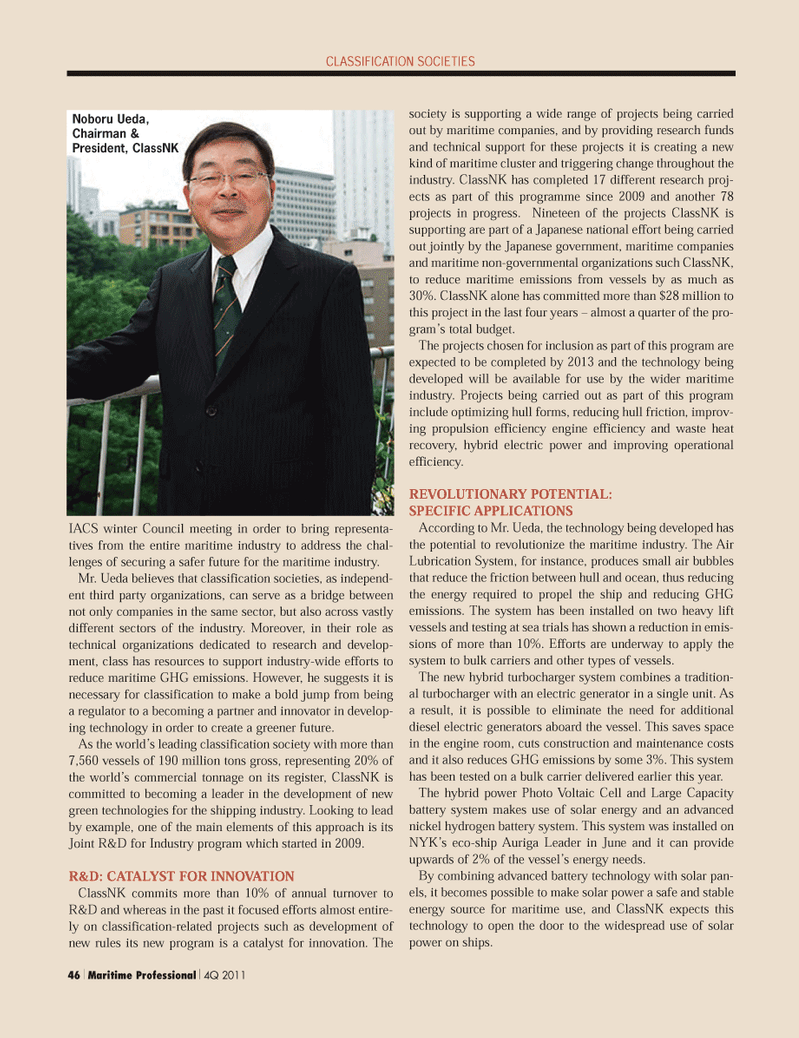
Page 46: of Maritime Logistics Professional Magazine (Q4 2011)
Classification
Read this page in Pdf, Flash or Html5 edition of Q4 2011 Maritime Logistics Professional Magazine
46 Maritime Professional 4Q 2011CLASSIFICATION SOCIETIES IACS winter Council meeting in order to bring representa- tives from the entire maritime industry to address the chal- lenges of securing a safer future for the maritime industry. Mr. Ueda believes that classification societies, as independ- ent third party organizations, can serve as a bridge between not only companies in the same sector, but also across vastly different sectors of the industry. Moreover, in their role as technical organizations dedicated to research and develop- ment, class has resources to support industry-wide efforts to reduce maritime GHG emissions. However, he suggests it is necessary for classification to make a bold jump from being a regulator to a becoming a partner and innovator in develop- ing technology in order to create a greener future. As the world?s leading classification society with more than 7,560 vessels of 190 million tons gross, representing 20% of the world?s commercial tonnage on its register, ClassNK is committed to becoming a leader in the development of new green technologies for the shipping industry. Looking to lead by example, one of the main elements of this approach is its Joint R&D for Industry program which started in 2009.R&D: CATALYST FOR INNOVATION ClassNK commits more than 10% of annual turnover to R&D and whereas in the past it focused efforts almost entire-ly on classification-related projects such as development of new rules its new program is a catalyst for innovation. The society is supporting a wide range of projects being carriedout by maritime companies, and by providing research funds and technical support for these projects it is creating a new kind of maritime cluster and triggering change throughout theindustry. ClassNK has completed 17 different research proj- ects as part of this programme since 2009 and another 78projects in progress. Nineteen of the projects ClassNK issupporting are part of a Japanese national effort being carried out jointly by the Japanese government, maritime companies and maritime non-governmental organizations such ClassNK, to reduce maritime emissions from vessels by as much as 30%. ClassNK alone has committed more than $28 million tothis project in the last four years ? almost a quarter of the pro-gram?s total budget. The projects chosen for inclusion as part of this program areexpected to be completed by 2013 and the technology being developed will be available for use by the wider maritime industry. Projects being carried out as part of this program include optimizing hull forms, reducing hull friction, improv- ing propulsion efficiency engine efficiency and waste heat recovery, hybrid electric power and improving operational efficiency. REVOLUTIONARY POTENTIAL: SPECIFIC APPLICATIONSAccording to Mr. Ueda, the technology being developed has the potential to revolutionize the maritime industry. The Air Lubrication System, for instance, produces small air bubbles that reduce the friction between hull and ocean, thus reducingthe energy required to propel the ship and reducing GHG emissions. The system has been installed on two heavy lift vessels and testing at sea trials has shown a reduction in emis- sions of more than 10%. Efforts are underway to apply the system to bulk carriers and other types of vessels. The new hybrid turbocharger system combines a tradition- al turbocharger with an electric generator in a single unit. As a result, it is possible to eliminate the need for additionaldiesel electric generators aboard the vessel. This saves space in the engine room, cuts construction and maintenance costsand it also reduces GHG emissions by some 3%. This system has been tested on a bulk carrier delivered earlier this year. The hybrid power Photo Voltaic Cell and Large Capacity battery system makes use of solar energy and an advanced nickel hydrogen battery system. This system was installed on NYK?s eco-ship Auriga Leader in June and it can provide upwards of 2% of the vessel?s energy needs. By combining advanced battery technology with solar pan- els, it becomes possible to make solar power a safe and stable energy source for maritime use, and ClassNK expects this technology to open the door to the widespread use of solarpower on ships. Noboru Ueda,Chairman &President, ClassNK MP #4 (34-49):MP Layouts 11/8/2011 2:11 PM Page 46

 45
45

 47
47
